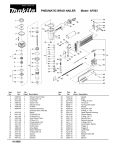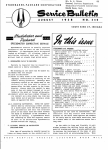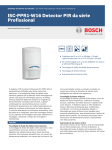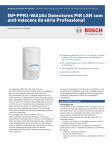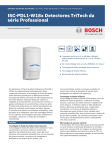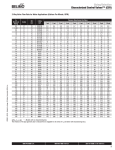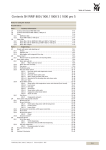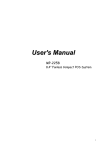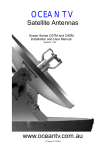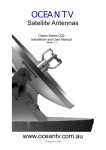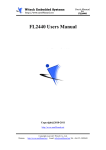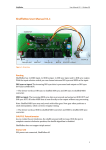Download LCD UNIT
Transcript
4. 1998. • • • This service manual is complied for repairing service of DOMESTIC SEWING MACHINE. BL6200, 6700 PS1000, 1250, 1800, 1950, 2000, 2100 STAR 10, 15, 20, 20E, 30E, 40E MYSTAR 15 Use this manual with Parts Catalogue for fault findings when you make a repair. This machine is manufactured based on up-to-date product specifications at the time of this issue, but there may be changes of specifications for improvements. Contact manufacturer or local sales company for such changes. Brother industries, Ltd. Nagoya, Japan CONTENTS I. II. III. IV. PRINCIPAL MECHANISMS ......................................................................... 1 TROUBLES AND CHECK POINTS ............................................................. 11 HOW TO ADJUST THE ELEMENTS ........................................................... 21 HOW TO CHANGE THE PARTS ................................................................. 58 1. 2. 3. 4. Always use rubber gloves when handling a printed circuit board, and do not touch the metal portion of the printed circuit board with bare hands. Keep the human body earthed to avoid generating static electricity. Pack a printed circuit board with aluminum foil and avoid impact with it while storing or transporting. Do not touch or damage the metal portion of a printed circuit board with a screwdriver or any other tool during repairing. -2- I. 1. 1. 2. 3. 3. 4. MECHANICAL CHART (B338, B346, B347, B348) .............................. 2 MECHANICAL CHART (B341, B349, B351, B352) .............................. 3 POWER TRANSMISSION CHART ...................................................... 4 DISPLAY SYSTEM BY MICRO-COMPUTER ...................................... 8 DISPLAY SYSTEM BY MICRO-COMPUTER ...................................... 9 MAIN MOTOR CONTROLLED BY MICRO-COMPUTER .................... 10 -1- 1. MECHANICAL CHART (B338 ⋅ B346 ⋅ B347 ⋅ B348) * This part is not installed on the B346 since it is a 4-step BH model. -2- 1. MECHANICAL CHART (B341 ⋅ B349 ⋅ B351 ⋅ B352) * These parts are not installed on the B341, B351 and B352 since they are LCD models. -3- 2. POWER TRANSMISSION CHART (A) Generating mechanism of needle bar, thread take-up lever and zigzag movements (B338 ⋅ B346 ⋅ B347 ⋅ B348) Thread take-up lever Eccentric counter weight Upper shaft Worm gear Needle bar crank rod Pattern cam Needle bar clamp Needle bar Needle bar supporter Zigzag connecting rod assembly Z finger Selecting cam Needle -4- Pulley (A) Generating mechanism of needle bar, thread take-up lever and zigzag movements (B341 ⋅ B349 ⋅ B351 ⋅ B352) Thread takeup lever Eccentric counter weight Upper shaft Worm gear Pulley Needle bar crank rod Pattern cam Needle bar clamp Needle bar Needle bar supporter Zigzag connecting rod assembly Z finger Needle -5- Selecting cam (B) Mechanism of feed dog and oscillating hook movement Feed pattern cam Feed finger Feed dog Feed regulator Horizontal feed cam Worm gear Forked connecting rod Pulley Motor belt Timing belt Outer rotary hook assembly Feed bar Lower shaft gear Vertical feed cam Horizontal feed plate * Rotary shatter Horizontal feed shaft Horizontal feed arm Lower shaft Drop lever * These parts are not installed on the B338, B346, B347 and B348. -6- Motor Timing pulley D (C) Automatic 1-step BH mechanism (B338 ⋅ B341 ⋅ B347 ⋅ B348 ⋅ B349 ⋅ B351 ⋅ B352) BH change shaft BH change arm BH stopper BH Iever Feed control cam (BH) BHF finger assembly BH cam BHF finger assembly 2-(A) BH foot -7- 2-(B) 3. DISPLAY SYSTEM BY MICRO-COMPUTER (B341 ⋅ B351) An 8 bit micro-computer in models installed with an LCD (liquid crystal display) regulates the LCD controller driver which controls the information shown on the display. <1 LINE DISPLAY SYSTEM BLOCK CHART> LCD panel Power supply circuit and motor control circuit Motor control P.C. board LCD unit LCD controller driver (SED1278) Contrast volume 8-bit MCU (M38004M8) Message key Pattern sensor BH Iever SW -8- Bobbin winder SW 3. DISPLAY SYSTEM BY MICRO-COMPUTER (B352) An 8 bit micro-computer in models installed with an LCD (liquid crystal display) regulates the LCD controller driver which controls the information shown on the display. <4 LINE DISPLAY SYSTEM BLOCK CHART> LCD panel LCD controller driver (NJU6426F) LCD segment driver (NJU6417F) LCD unit Power supply circuit and motor control circuit Motor control P.C. board LCD control P.C. board Contrast volume ROM (HN62302BF) 8-bit MCU ( M38002SFP) A, B, ↓,↑ keys EEPROM (X24C00P) Pattern sensor -9- BH Iever SW Bobbin winder SW 4. MAIN MOTOR CONTROLLED BY MICRO-COMPUTER (B341 ⋅ B349 ⋅ B351 ⋅ B352) The sewing machine’s main motor requires a constant rotation at all speeds regardless of the changes in the load, power supply or temperature. In addition, to make the machine easy to use, it should take into account that the machine should run slowly when it starts and the needle should be in the up position when it stops. To execute these requirements, the main motors of these sewing machines are controlled by a microcomputer. <MOTOR CONTROL BLOCK CHART> Reset circuit NP sensor Speed volume Drive circuit CPU Foot controller SS Switch Speed sensor 30pins Bobbin winder sw Reverse sw - 10 - Motor II. 1. 2. 3. 4. 5. 6. 7. 8. 9. 10. 11. 12. 13. 14. 15. 16. 17. 18. 19. 20. 21. 22. 23. 24. 25. 26. 27. Machine skips stitches. ........................................................................ 13 Fabric does not feed. ........................................................................... 13 Fabric does not feed straight. .............................................................. 13 Upper thread breaks at start. ............................................................... 13 Upper thread breaks during sewing. .................................................... 13 Upper thread breaks during reverse sewing. ....................................... 13 Lower thread breaks. ........................................................................... 13 Needle breaks. .................................................................................... 14 Noise ................................................................................................... 14 Forward and reverse feedings differ. ................................................... 14 Improper length of buttonhole legs. ..................................................... 14 Improper buttonhole size against button size. ...................................... 14 Unbalanced patterns. ........................................................................... 14 Needle hits needle plate when pattern selector dial is turned. ............. 14 Fabric gathers. ..................................................................................... 14 The stitch shown in the pattern indication window is different from the one being sewn. ....................................................... 14 No characters appear on the LCD. ...................................................... 15 The message keys do not work. .......................................................... 15 The LCD contrast cannot be adjusted. ................................................ 15 The wrong pattern name appears on the LCD. .................................... 15 The "Bobbin Winding" message continues to appear on the LCD. ...... 16 The "Bobbin Winding" message does not appear on the LCD when the machine is set for bobbin winding.(1 line LCD) ..................... 16 Message "Bobbin Winding Selected" does not appear when bobbin winding is set. (4 line LCD). ............................................ 16 Message "Lower BH Lever" does not appear when buttonhole is set and buttonhole lever is not lowered. (1 line LCD). .......................... 16 Message "Lower Buttonhole Lever" does not appear when buttonhole is set and buttonhole lever is not lowered. (4 line LCD). .......................... 16 Message "Lower BH Lever" appears when buttonhole lever is lowered. ................................................................................... 17 The light does not turn on even after the power is turned on. .............. 17 - 11 - 28. The motor does not run. ...................................................................... 18 29. The motor does not run smoothly or it does not run at a high speed. ................................................................................... 18 30. Even after the machine is started, it stops suddenly. ........................... 18 31. The speed at which the machine operates cannot be adjusted. .......... 19 32. The needle does not stop in the up position. ....................................... 19 33. The machine does not operate if the reverse sewing button is pressed or does not operate at a slow speed if the button is pressed while the machine is running. ................................................. 19 34. The machine stops immediately after bobbin winding is started. ......... 20 35. The machine does not operate when the foot controller is depressed. ........................................................................................... 20 - 12 - PROBLEM 1. Machine skips stitches. CAUSE 1. 2. 3. 4. 5. 6. 7. 8. CORRECTION Improper setting of the needle. Bent or blunt needle. Improper threading. Improper combination of needle/ thread/fabric. Stretch fabric is used. Improper timing of the needle and rotary hook. Improper height of the needle bar. Improper clearance between the needle and rotary hook. Set the needle correctly. Change the needle. Reset threading correctly. Select correct combination of needle/ thread/fabric. Use stretch fabric needle, optional stretch presser foot. Refer to P.28. Refer to P.29. Refer to P.28. 2. Fabric does not feed. 1. 2. 3. 4. 5. Stitch length is set at "O". Improper height of feed dog. Thick fabric. Feed dog is worn out. The feed dog is lowered. Set proper stitch length. Refer to P.32. Change the fabric. Change the feed dog. Raise the feed dog with the drop lever. 3. Fabric does not feed straight. 1. Uneven pressure on right/left side of presser foot Change the presser foot and the feed dog. 4. Upper thread breaks at start. 1. Improper threading. Thread correctly. 5. Upper thread breaks during sewing. 1. 2. 3. 4. 5. 6. 7. 8. 9. Bent or blunt needle. Improper setting of needle. Thread tension is too tight. Thread is tangled. Inferior needle eye. Inferior needle slot of needle plate. Inferior upper thread path. Inferior thread. Needle hits needle plate or outer rotary hook. Change the needle. Set the needle correctly. Adjust tension control dial correctly. Thread correctly. Change the needle. Change the needle plate. Clean or replace. Check or change the thread. Set the needle bar and outer rotary hook correctly. * Refer to P.28. Change inner rotary hook. 10. There are scratches on inner rotary hook. 6. Upper thread breaks during reverse sewing. 1. 2. Fabric is pulled excessively. Improper use of reverse sewing button. Guide the fabric. Push reverse sewing button as far as it will allow. 7. Lower thread breaks. 1. Lower thread tension is too tight. 2. Too much thread is wound on bobbin. 3. 4. Thread is tangled. Bobbin does not turn in inner rotary hook. Inferior thread. Adjust the tension by loosening the tension spring. screw on inner rotary hook. Change to other bobbin or adjust bobbin winder. Thread correctly. Change the bobbin. 5. - 13 - Check or change the thread. PROBLEM 8. Needle breaks. CAUSE 1. CORRECTION 2. Touch pattern dial while needle is in the fabric. Needle hits inner rotary hook. 3. Needle hits needle plate. 4. 5. 7. 8. Bent or blunt needle. Improper clearance between the needle and the outer rotary hook. Machine feeds while needle is in the fabric. Needle flows. Fabric is pulled excessively. 1. 2. 3. 4. Play of worm/pattern cam gear. Play of lower shaft. Play of upper shaft. Noise from rotary hook. Adjust to proper gearing. Adjust play of the lower shaft. Adjust play of the upper shaft. Clean the race of inner rotary hook and outer rotary hook or replace inner rotary hook. 10. Forward and reverse feedings differ. 11. Improper length of buttonhole legs. 1. Improper adjustment of revers sewing lever. Refer to P.46. 1. Improper adjustment. Adjust screw. * Refer to P.42. 12. Improper buttonhole size against button size. 1. Improper adjustment of buttonhole length. Adjust the length of buttonhole. * Refer to P.44. 13. Unbalanced patterns. 1. 2. Stitch length dial is not set at ’’4’’. Feed dog is worn out. 3. 4. 5. 6. Improper height of feed dog. Improper attachment of feed dog. Forward and reverse feedings differ. Stitch width dial is not set to "5". Operate machine correctly. Change the feed dog. * Refer to P.31, P.32. Refer to P.32. Attach the feed dog correctly. Refer to P.40. Operate machine correctly. 14. Needle hits needle plate when pattern selector dial is turned. 1. Release volume is too big. Adjust the release volume. * Refer to P.37. 15. Fabric gathers. 1. 2. 3. Thread tension is too tight. Blunt needle. Improper combination of needle/ thread/fabric. Improper threading. Reduce the tension. Change the needle. Select correct combination of needle/ thread/fabric. Reset threading correctly. Release volume is too small. The indicate gear and pattern indicator plate are not aligned correctly. Adjust the release volume. * Refer to P.37. Adjust the pattern indicator. * Refer to P.36. 6. 9. Noise. 4. 16. The stitch shown in the pattern indication window is different from the one being sewn. 1. 2. - 14 - Operate machine correctly. Adjust the position of inner rotary hook stopper. * Refer to P.30. Make sure the correct needle is used. * Refer to P.27, P.37. Change needle. Refer to P.28. Refer to P.25, P.26. Refer to P.27. Guide the fabric. PROBLEM 17. No characters appear on the LCD. 1. 2. 3. 4. CAUSE CORRECTION 1 line LCD 1 line LCD Improper setting of LCD contrast key. Disconnection of connector CN 1. Voltage between terminal 2-1 of LW1 on motor control unit is less than DC5V. Inferior LCD unit. 4 line LCD 1. 2. 3. 4. 5. 18. The message keys do not work. Improper setting of LCD contrast manual. Disconnection of connector P1. Disconnection of connector P5. Voltage between terminal 2-1 of LW1 on motor control unit is less than DC5V. Inferior LCD control PCB or LCD module. 19. The LCD contrast cannot be adjusted. Message key top does not work. Inferior LCD unit. Each key tops do not work. Inferior LCD control PCB. 1 line LCD 1. 2. LCD contrast key does not work. Improper LCD contrast. 4 line LCD 1. 2. 20. The wrong pattern name appears on the LCD. 2. LCD contrast key does not work. Improper LCD control PCB. 2. Replace the LCD control PCB or LCD module. Check the message key and key top. Replace the LCD unit. 4 line LCD (A,B,↓,↑) Check each keys and key tops. Replace the LCD control PCB. 1 line LCD Check the slide volume and slide key. Replace the LCD unit. Check the slide volume and slide key. Replace the LCD control PCB. 1 line LCD Disconnection of connector CN2 on LCD unit. Inferior LCD unit or pattern sensor. 4 line LCD 1. Connect P1 on LCD control PCB. Connect P5 on LCD module. Replace the motor control unit. 4 line LCD 1 line LCD 1. Adjust LCD contrast manual. 1 line LCD 4 line LCD (A,B,↓,↑) 1. 2. Replace the LCD unit. 4 line LCD 1 line LCD 1. 2. Adjust LCD contrast key. Connect CN1 on LCD unit. Replace the motor control unit. Connect CN2 on LCD unit. Replace the LCD unit or pattern sensor. 4 line LCD Disconnection of connector P3 on LCD control PCB. Inferior LCD control PCB or pattern sensor. - 15 - Connect P3 on LCD control PCB. Replace the LCD control PCB or pattern sensor. PROBLEM CAUSE CORRECTION 21. The "Bobbin Winding" message continues to appear on the LCD. 1 line LCD 1 line LCD 1. BW switch does not work. 2. Inferior BW switch. 3. Inferior LCD unit. 4 line LCD 22. The "Bobbin Winding" message does not appear on the LCD when the machine is set for bobbin winding. (1 line LCD). 23. Message "Bobbin Winding Selected" does not appear when bobbin winding is set. (4 line LCD) 24. Message "Lower BH Lever" does not appear when buttonhole is set and buttonhole lever is not lowered. (1 line LCD) 25. Message "Lower Buttonhole Lever" does not appear when buttonhole is set and buttonhole lever is not lowered. (4 line LCD) Adjust the BW stitch. *Refer to P.51. Replace the BW switch. *Refer to P.51. Replace the LCD unit. 4 line LCD 1. 2. 3. BW switch does not work. Inferior BW switch. Inferior LCD control PCB. Adjust the BW stitch. *Refer to P.51. Replace the BW switch. *Refer to P.51. Replace the LCD control PCB. 1. Connect CN1 on LCD unit. 3. Disconnection of connector CN1 on LCD unit. Disconnection of connector CN5 on Motor control unit. BW switch does not work. 4. Inferior BW switch. 5. Inferior LCD unit. 1. 3. Disconnection of connector P1 on LCD control PCB. Disconnection of connector CN5 on Motor control unit. BW switch does not work. 4. Inferior BW switch. 5. Inferior LCD control PCB. 1. 3. Disconnection of connector CN3 on LCD unit. Disconnection of connector CN7 on Motor control unit. BH lever switch does not work. 4. Inferior BH lever switch. 5. Inferior LCD unit. 1. 3. Disconnection of connector P2 on LCD control PCB. Disconnection of connector CN7 on Motor control unit. BH lever switch does not work. 4. Inferior BH lever switch. 5. Inferior LCD control PCB. 2. 2. 2. 2. - 16 - Connect CN5 on Motor control unit Adjust the BW stitch. *Refer to P.51. Replace the BW switch. *Refer to P.51. Replace the LCD unit. Connect the P1 on LCD control PCB. Connect the CN5 on Motor control unit. Adjust the BW switch. *Refer to P.51. Replace the BW switch. *Refer to P.51. Replace the LCD control PCB. Connect the CN3 on LCD unit. Connect the CN7 on Motor control unit. Adjust the BH lever switch. *Refer to P.49. Replace the BH lever switch. *Refer to P.49. Replace the LCD unit. Connect the P2 on LCD control PCB. Connect the CN7 on Motor control unit. Adjust the BH lever switch. *Refer to P.49. Replace the BH lever switch. *Refer to P.49. Replace the LCD control PCB. PROBLEM CAUSE CORRECTION 26. Message "Lower BH Lever" appears when button-hole lever is lowered. 1 line LCD 1 line LCD 1. BH lever switch does not work. 2. Inferior BH lever switch 3. Inferior LCD unit 4 line LCD 27. The light does not turn on even after the power is turned on. 4 line LCD 1. BH lever switch does not work. 2. Inferior BH lever switch 3. Inferior LCD control PCB 1. The voltage on both ends of connector CN1 is not 100 V AC when the AC cord is inserted. The resistance on both ends of the power switch is not less than 1 Ω when the power is turned on.* The fuse is broken. The light does not turn on. (The light may be damaged or deteriorating or it may have a bad connection.) Remove the light and measure the resistance on both ends. It should be less than 3 Ω.* The output from the transformer is incorrect. When connector CN4 is disconnected from the motor control unit and the power is turned on, the voltage between pins 1 and 2 of connector CN4 should be approximately 10V AC. Other causes. 2. 3. 4. 5. 6. Adjust the BH lever switch. *Refer to P.49. Replace the BH lever switch. *Refer to P.49. Replace the LCD unit. Adjust the BH lever switch. *Refer to P.49. Replace the BH lever switch. *Refer to P.49. Replace the LCD control PCB. Replace either the AC cord or the motor control unit. Replace the motor control unit. Replace the motor control unit. Replace the light. Replace the motor control unit. Replace the motor control unit. * Be sure to turn off the power and remove from the PCB the connector. - 17 - PROBLEM 28. The motor does not run. CAUSE 1. The pulley is turned too tightly. 2. The resistance between the two ends of motor connector CN2 is not between 25 and 35 Ω.* Inferior SS switch. The resistance between pins 4 and 5 of the SS-VR PCB unit connector should be less than 1 Ω when the SS switch is turned on and Ω when the SS switch is turned off.* Inferior BT switch. The resistance between pins 1 and 2 of connector CN6 (red) should be less than 1 Ω when the BT switch is turned on and ∞ when the BT switch is turned off.* The resistance between pins 2 and 3 of the pin jack assembly on the PCB (F.C.) should not be less than 1 Ω when the foot controller is not inserted.* Other causes. 3. 4. 5. 6. 29. The motor does not run smoothly or it does not run at a high speed. 1. 2. 3. 4. 5. 6. 7. 8. 30. Even after the machine is started, it stops suddenly. CORRECTION 1. 2. Adjust the mechanism so that the pulley rotates easily. Replace the motor. Replace the SS-VR PCB unit. Replace the BT switch. *Refer to P.50. Replace the motor control unit. Replace the motor control unit. The Pulley is sometimes easy or sometimes difficult to move when it is rotated by hand. Accumulated lint or thread under the needle plate. Improper tension in motor belt and timing belt. Tight gearing of the pattern cam gear and worm gear. The rotary shutter is dirty. The motor control unit is installed incorrectly. It is loose or slanted. The voltage between pins 2+ and 3- on the SS-VR PCB does not stay between 0 and 5 V DC when the power is turned on and the speed adjustor is slid to the maximum. Other causes. Adjust the mechanism so that the pulley rotates easily. The motor control unit is installed incorrectly. It is loose or slanted. Other causes. Install the motor control unit correctly. Clean inner rotary hook, outer rotary hook and feed dog. Refer to P.25. Refer to P.27. Clean the rotary shutter. Install the motor control unit correctly. Replace the SS-VR PCB unit. Replace the motor control unit. Replace the motor control unit. * Be sure to turn off the power and remove from the PCB the connector. - 18 - PROBLEM 31. The speed at which the machine operates cannot be adjusted. CAUSE The output from the transformer is incorrect. The voltage between pins 5 and 6 of the transformer should be approximately 8V AC. The voltage between the S V and GND on the motor control unit is incorrect. It should be 5±0.25 V DC. The voltage between pins 2+ and 3- on the SS-VR PCB does not stay between 0 and 5 V DC when the power is turned on and the speed adjustor is slid to the maximum. Other causes. Replace the motor control unit Check and adjust if necessary. *Refer to P.48. Install the motor control unit correctly. 4. The position of the NP sensor shutter is incorrect. The motor control unit is installed incorrectly. It is loose or slanted. Inferior BW switch. The resistance between pins 1 and 2 of connector CN5 (black) should be less than 1Ω when the BW switch is turned on and ∞ when the BW switch is turned off.* Other causes. 1. The BT switch dose not work. 2. Inferior BT switch. The resistance between pins 1 and 2 of connector CN6 (red) should be less than 1Ω when the BT switch is turned on and ∞ when the BT switch is turned off.* Other causes. Check and adjust if necessary. *Refer to P.50. Replace the BT switch. *Refer to P.50. 1. 2. 3. 4. 32. The needle does not stop in the up position. 1. 2. 3. 33. The machine does not operate if the reverse sewing button is pressed or does not operate at a slow speed if the button is pressed while the machine is running. (However, the machine does not operate at slow speed when the foot controller is being used.) CORRECTION 3. Replace the motor control unit. Replace the SS-VR PCB unit. Replace the motor control unit. Replace the BW switch. *Refer to P.51. Replace the motor control unit. Replace the motor control unit. * Be sure to turn off the power and remove from the PCB the connector. - 19 - PROBLEM 34. The machine stops immediately after bobbin winding is started. CAUSE 1. 2. 35. The machine does not operate when the foot controller is de pressed. 1. 2. 3. CORRECTION If the machine stops approx. 1 second after bob-bin winding starts, the BW switch is not operating correctly.* The resistance between pins 1 and 2 of connector CN5 (black) should be less than 1 Ω when the BW switch is turned on and ∞ when the BW switch is turned off. Other causes. Replace the BW switch. *Refer to P.51. The foot controller is not operating properly. The resistance between the two ends of the foot controller plug is not less than 10 KΩ.* The resistance between pins 2 and 3 of the pin jack assembly on the PCB (F.C.) should be less than 1 Ω when the foot controller is plugged in and ∞ when it is not plugged in.* Other causes. Replace the foot controller. Replace the motor control unit. Replace the motor control unit. Replace the motor control unit. * Be sure to turn off the power and remove from the PCB the connector. - 20 - III. 1. 1. 2. 3. 4. 5. 6. 7. 8. 9. 10. 11. 12. 13. 14. 15. 16. 17. 18. 19. 20. 21. 22. 23. 24. 25. 26. 27. 28. 29. 30. 31. 32. 33. 34. 35. ! ADJUSTMENT OF EACH CONTROL UNIT (4-STEP BH MODEL) ............... 22 ADJUSTMENT OF EACH CONTROL UNIT (1-STEP BH MODEL) ............... 23 ADJUSTMENT OF THE TIMING BETWEEN THE UPPER AND LOWER SHAFTS ..... 24 TENSION ON MOTOR BELT AND TIMING BELT ......................................... 25 TIMING OF NEEDLE BAR AND FEED ........................................................... 26 POSITION OF ZIGZAG NEEDLE SWING ...................................................... 27 POSITION OF ROTARY HOOK ..................................................................... 28 HEIGHT OF NEEDLE BAR ............................................................................. 29 POSITION OF INNER ROTARY HOOK STOPPER ....................................... 30 POSITION OF FEED DOG ............................................................................. 31 HEIGHT OF FEED DOG ................................................................................. 32 HEIGHT OF PRESSER BAR .......................................................................... 33 ADJUSTMENT OF THREAD TENSION DIAL ................................................ 34 ADJUSTMENT OF AUTO TENSION .............................................................. 35 POSITION OF PATTERN INDICATION PLATE ............................................. 36 CLEARANCE BETWEEN CAM AND CAM FINGER ...................................... 37 POSITION OF CAM FINGER FOR FEED CAM AND PATTERN CAM .......... 38 SETTING OF FEED BRACKET ...................................................................... 39 FORWARD AND REVERSE SEWING FOR RICK-RACK STITCH ................ 40 ADJUSTMENT OF FEED ............................................................................... 41 BUTTONHOLE ADJUSTMENT (FORWARD AND REVERSE FEEDING) .... 42 BUTTONHOLE ADJUSTMENT (BAR TACK FEEDING) ................................ 43 BUTTONHOLE ADJUSTMENT (THE LENGTH OF THE BUTTONHOLE AND THE PRESSURE OF THE BH LEVER) ................................................. 44 MAXIMUM STITCH WIDTH WHEN SET AT STRAIGHT (LEFT) AND ZIGZAG STITCH .................................................................................... 45 FORWARD AND REVERSE FEEDING FOR STRAIGHT STITCH ................ 46 ADJUSTMENT OF BOBBIN WINDING .......................................................... 47 POSITION OF N.P. (NEEDLE POSITION) SHUTTER ................................... 48 ADJUSTMENT OF BH LEVER SWITCH ........................................................ 49 ADJUSTMENT OF REVERSE SEWING SWITCH ......................................... 50 ADJUSTMENT OF BOBBIN WINDING SWITCH ........................................... 51 ADJUSTMENT OF INNER ROTARY HOOK TENSION ................................. 52 NEEDLE THREADER ..................................................................................... 53 NEEDLE THREADER (CHECKING THE HOOK POSITION IN HORIZONTAL DIRECTION) ........................................................................... 54 NEEDLE THREADER (EXCHANGE) ............................................................. 55 NEEDLE THREADER (CHECKING THE HOOK POSITION IN VERTICAL DIRECTION) ................................................................................. 56 NEEDLE THREADER (ADJUSTMENT THE HOOK POSITION IN VERTICAL DIRECTION) ................................................................................. 57 - 21 - 1. ADJUSTMENT OF EACH CONTROL UNIT (4-STEP BH MODEL) (B346) - 22 - 1. ADJUSTMENT OF EACH CONTROL UNIT (1-STEP BH MODEL) (B338 ⋅ B341 ⋅ B347 ⋅ B348 ⋅ B349 ⋅ B351 ⋅ B352) - 23 - 2. ADJUSTMENT OF THE TIMING BETWEEN THE UPPER AND LOWER SHAFTS STANDARD When the mark on the horizontal feed cam of the upper shaft is at its topmost position, the mark on timing pulley D of the lower shaft should be at its bottommost position. (Turn pulley counterclockwise.) ADJUSTMENT 1. 2. 3. Remove the timing belt from the horizontal feed cam, the tension pulley and timing pulley D. Position the mark on the horizontal feed cam so it is at its topmost position and the mark on timing pulley D so it is at its bottommost position. Install the timing belt onto the horizontal feed cam, the tension pulley and timing pulley D. - 24 - 3. TENSION ON MOTOR BELT AND TIMING BELT STANDARD There should be 4 ~ 6 mm of slack on the motor belt, 3 ~ 4 mm of slack on timing belt, when the center of each belt is just pushed with about 200g pressure. ADJUSTMENT 1. 2. 3. 4. 5. 6. Loosen two screws on the motor holder. Adjust tension on timing belt by moving motor holder. Tighten two screws. Loosen the screw on tension pulley. Adjust tension on timing belt by moving tension pulley. Tighten the screw. - 25 - 4. TIMING OF NEEDLE BAR AND FEED (B341 ⋅ B349 ⋅ B351 ⋅ B352) STANDARD When the needle bar is at its highest position, the mark on the horizontal feed cam should be at its topmost position. (Horizontal feed should start when needle bar reaches at the position of -7 ~ -17° from its highest position.) (Turn the pulley counterclockwise.) ADJUSTMENT 1. 2. 3. 4. 5. 6. 7. 8. Set pattern dial to straight stitch and stitch length to "4". Loosen two screws on eccentric counter weight. Adjust the eccentric counter weight so the needle is at its highest point when the mark on the horizontal feed cam of the upper shaft is at its topmost position. Tighten two screws. Make sure that timing was adjusted correctly by turning the pulley counterclockwise. Loosen two screws of thread control cam. Fit the both marks of thread control cam and eccentric counter weight by turning the thread control cam. Tighten two screws. - 26 - 5. POSITION OF ZIGZAG NEEDLE SWING STANDARD Set pattern dial to zigzag stitch. The needle should drop in the needle hole balanced. When the zigzag width dial is turned from "0" to "5" while the needle is in the right position, horizontal movement of the needle should be less than 0.1 mm. Needle swing on the way up from lowest position to needle plate should be less than 0.15 mm and that on the way down from needle plate to lowest position should be less than 0.05 mm. ADJUSTMENT 1. 2. 3. Set pattern dial to zigzag stitch. Loosen the zigzag gear lever fixing screw. Move the zigzag connecting rod to its lowest position (where the roller of zigzag connecting rod contacts unit base F) while keeping the zigzag width dial at the minimum, "0", and while preventing backlash in the gear. 4. Tighten the screw. 5. Set zigzag width dial to "5" and set the right position of needle by turning the pulley. 6. Turn zigzag width dial from "0" to "5" and adjust eccentric nut so that the needle does not swing. 7. Set zigzag width dial to "5" and adjust eccentric nut so that the needle drops in the needle hole balanced. 8. Loosen three set screws on worm gear. 9. Adjust needle swing by turning worm gear. 10. Tighten three screws. NOTE Make sure that there is no clearance between worm gear and pattern cam gear. - 27 - 6. POSITION OF ROTARY HOOK STANDARD When pattern dial is set to zigzag stitch, zigzag width dial is set to "5" (the needle is at the left side) and needle raises from its lowest position by 2.75 ~ 3.15 mm, the pointed end of rotary hook should meet with right side of needle. Under this condition, clearance between the hook and the needle should be less than 0.1 mm and the hook should not hit the needle. ADJUSTMENT 1. 2. 3. 4. 5. Set pattern dial to zigzag stitch and zigzag width dial to "5". (the needle is at the left side) Loosen three screws on lower shaft gear. Adjust position of rotary hook. (When needle raises from its lowest position by 2.75 ~ 3.15 mm, the pointed end of rotary hook should meet with right side of the needle.) Tighten three screws. Adjust clearance by turning clearance adjusting eccentric screw. - 28 - 7. HEIGHT OF NEEDLE BAR STANDARD When pattern dial is set to the zigzag stitch, the zigzag width dial is set to "5" (the needle is at the left side) and the pointed end of the rotary hook contacts the right side of the needle, the clearance between the top of the needle eye and the hook point should be 0.8 ~ 1.2 mm. ADJUSTMENT 1. 2. 3. 4. 5. Set pattern dial to zigzag stitch and zigzag width dial to "5". (the needle is at the left side) Set position so that hook point meet with right side of the needle by turning the pulley. Loosen the screw on needle bar holder. Adjust height of needle clamp. Tighten the screw. - 29 - 8. POSITION OF INNER ROTARY HOOK STOPPER STANDARD Inner rotary hook stopper should hold inner rotary hook by 1.9 ~ 2.1 mm as shown in drawing. ADJUSTMENT 1. 2. 3. Loosen the screw on inner rotary hook stopper. Adjust the position of inner rotary hook stopper. (Face A on inner rotary hook and feed direction should be at right angles.) Tighten the screw. - 30 - 9. POSITION OF FEED DOG STANDARD When the upper shaft is rotated once with the maximum feed, the feed dog should not contact the needle plate on the left and right. When the feed dog is in its initial feed position (as far forward as possible), the clearances between the feed dog and the needle plate should be 0.3 ~ 0.8 mm. ADJUSTMENT 1. 2. 3. 4. 5. 6. 7. Loosen two screws on the horizontal feed plate. Adjust the left and right sides of the feed dog. Tighten two screws. Turn the pulley to move the feed dog to its initial feed position. Loosen the screw on the horizontal feed arm. Adjust the arm so the clearance between the feed dog and the needle plate is between 0.3 ~ 0.8 mm. Tighten the screw. - 31 - 10. HEIGHT OF FEED DOG STANDARD Feed dog should be higher than the needle plate by 0.9 ~ 1.1 mm when the feed dog is raised to its highest position. ADJUSTMENT 1. 2. 3. 4. Raise the feed dog using the drop lever, then raise the feed dog to its highest position by turning the pulley. Loosen the screw for vertical feed finger. Adjust the height of the feed dog by turning vertical feed finger. Tighten the screw. - 32 - 11. HEIGHT OF PRESSER BAR STANDARD The clearance between presser foot and needle plate should be 6.0 ~ 6.5 mm. ADJUSTMENT 1. 2. 3. 4. Raise presser foot. Loosen the screw on presser bar guide bracket. Adjust height of presser bar. (Presser foot should be parallel to feed dog.) Tighten the screw. (B341 ⋅ B349 ⋅ B351 ⋅ B352) (B338 ⋅ B346 ⋅ B347 ⋅ B348) - 33 - 12. ADJUSTMENT OF THREAD TENSION DIAL (B341 ⋅ B349 ⋅ B351 ⋅ B352) STANDARD When thread tension dial is set to "AUTO" and presser foot is lowered, upper thread tension should be 10 ~ 13g using polyester thread #60. ADJUSTMENT 1. 2. 3. 4. Set thread tension dial to "AUTO", put polyester thread between tension discs and lower presser foot. Loosen the screw for thread tension control screw. Measure thread tension using tension gauge and adjust tension to 10 ~ 13g by turning thread tension control screw. Tighten the screw. (B338 ⋅ B346 ⋅ B347 ⋅ B348) STANDARD When thread tension dial is set to "4" and presser foot is lowered, upper thread tension should be 33 ~ 38g using polyester thread #60. ADJUSTMENT 1. 2. 3. 4. Set thread tension dial to "4", put polyester thread between tension discs and lower presser foot. Loosen the screw for thread tension control screw. Measure thread tension using tension gauge and adjust tension to 33 ~ 38g by turning thread tension control screw. Tighten the screw. - 34 - 13. ADJUSTMENT OF AUTO TENSION (B341 ⋅ B349 ⋅ B351 ⋅ B352) (ADJUSTMENT OF ROLLER FOR THREAD TENSION CONTROL) STANDARD Thread polyester thread #60 between roller and thread holder. Turn the pully counterclockwise. The thread should be locked when the top of the needle eye comes down 0 ~ 1.5 mm down from the surface of needle plate. (Remove presser foot and lower presser foot bar.) ADJUSTMENT 1. 2. 3. 4. 5. Set pattern dial to straight stitch and lower the presser foot after threading polyester thread #60 properly. Turn the pulley counterclockwise and adjust needle position at the top of needle eye 0 ~ 1.5 mm down from the surface of needle plate. Loosen the screw for roller adjusting shaft. Turn the roller adjusting shaft by screw driver and adjust the roller position in between lock and release condition with drawing thread. (Adjust the roller so it is within one cycle of the roller adjusting shaft.) Tighten the screw. NOTE Turn the pulley counterclockwise 2 ~ 3 times. Check if the roller should lock thread when top of needle eye 0 ~ 1.5 mm down from the surface of needle plate. Also check if thread tension is proper on 2 pcs of broad with needle #14(No. 90), polyester thread #60. - 35 - 14. POSITION OF PATTERN INDICATION PLATE (B338 ⋅ B346 ⋅ B347 ⋅ B348 ⋅ B349) STANDARD Each pattern on indication plate should be indicated at the center of the indication window. ADJUSTMENT 1. 2. 3. 4. Set pattern dial to zigzag stitch and check baseline on selecting cam which should meet with upper end of release lever. Loosen two screws on indication gear. Set the symbol of zigzag stitch at the center of the indication window by turning indication gear. Tighten two screws. NOTE After adjustment, make sure each pattern is indicated at the center of the indication window by turning pattern dial. - 36 - 15. CLEARANCE BETWEEN CAM AND CAM FINGER STANDARD When pattern dial is set to rick-rack stitch and cam finger is released, clearance between cam finger and pattern cam & feed cam should be 0.3 ~ 0.5 mm. ADJUSTMENT 1. 2. 3. 4. Set pattern dial to rick-rack stitch and release cam finger from pattern and feed cam. Loosen the nut to release adjustment screw. Adjust clearance by turning release adjustment screw. Tighten the nut. - 37 - 16. POSITION OF CAM FINGER FOR FEED CAM AND PATTERN CAM STANDARD Feed cam finger and zigzag cam finger should be center position of each cam. ADJUSTMENT 1. 2. 3. 4. 5. Check the position of feed cam finger and zigzag cam finger by turning pattern dial. Loosen the screw on selecting lever holder. Set the Z cam finger and F cam finger to the center position of each cam by adjust selecting lever holder. Tighten the screw. Make sure cam finger is located at the center position of each cam by turning pattern dial. • The shape of the cams on the B346 differ slightly. - 38 - 17. SETTING OF FEED BRACKET STANDARD When stitch length dial is set to "0", each mark on feed dial gear, feed gear, feed cam and feed finger should meet in line. ADJUSTMENT 1. 2. 3. 4. 5. Set stitch length dial to "0". Set the mark on the feed cam to feed finger. Set the mark on the feed gear to the mark on feed cam. Set the mark on the feed dial gear to the mark on feed gear. Fix the feed bracket by tightening two screws. - 39 - 18. FORWARD AND REVERSE SEWING FOR RICK-RACK STITCH STANDARD When pattern dial is set to rick-rack stitch, there should be no difference between forward and reverse feed. ADJUSTMENT 1. 2. 3. 4. Set pattern dial to rick-rack stitch. Loosen the nut for adjustment screw. Adjust forward and reverse feeding by turning screw. Tighten the nut. - 40 - 19. ADJUSTMENT OF FEED STANDARD When stitch length dial is set to "0", stitch length should be 0 mm. ADJUSTMENT 1. 2. 3. 4. Set the pattern dial to the zigzag stitch, the zigzag width dial to "5" and the stitch length dial to "0". Loosen the screw on feed dial gear. Turn feed dial gear slightly so that stitch length become 0 mm. Tighten the screw. - 41 - 20. BUTTONHOLE ADJUSTMENT (FORWARD AND REVERSE FEEDING) 1 STEP BH MODEL (B338 ⋅ B341 ⋅ B347 ⋅ B348 ⋅ B349 ⋅ B351 ⋅ B352) STANDARD When pattern dial is set to "1" (Buttonhole), there should be no feeding difference between left and right legs. ADJUST 1. 2. 3. 4. 5. 6. 7. Set pattern dial to "1" (Buttonhole). Set stitch length dial to "F" and lower the B.H Lever. After that, get the trial buttonhole stitch. Set BH adjusting eccentric stud to fig. 3. Sew the trial buttonhole stitch then check the difference of sewing pitch between right and left rows. Loosen the nut for buttonhole feed adjusting screw. Adjust forward and reverse feeding by turning the screw. Tighten the nut. 4 STEP BH MODEL (B346) STANDARD When pattern is set to "b" and "d", there should be no feeding difference between left and right legs. ADJUSTMENT 1. 2. 3. 4. 5. 6. 7. Set pattern dial to "d". Set stitch length dial to "F". Set BH adjusting eccentric stud to fig. 3. Set pattern dial to "b" and sew left row of buttonhole then check the difference of sewing pitch between right and left rows Loosen the nut for adjusting screw. Adjust forward and reverse feeding by turning the screw. Tighten the nut. - 42 - 21. BUTTONHOLE ADJUSTMENT (BAR TACK FEEDING) 1 STEP BH MODEL (B338 ⋅ B341 ⋅ B347 ⋅ B348 ⋅ B349 ⋅ B351 ⋅ B352) STANDARD The feeding of bar tack should be less than 1 mm/10 feedings. ADJUSTMENT 1. 2. 3. 4. Set pattern dial to "1" (Buttonhole). Loosen the nut for bar tack feeding adjusting screw. Adjust the screw. If forward feeding is obtained ................................... Turn screw counterclockwise. If back feeding is obtained ........................................ Turn screw clockwise. Tighten the nut. 4 STEP BH MODEL (B346) STANDARD The feeding of bar tack should be less than 1.0 mm/10 feedings. ADJUSTMENT 1. 2. 3. 4. Set pattern dial to "ac". Loosen the nut for bar tack feeding adjusting screw. Adjust the screw. If forward feeding is obtained ................................... Turn screw counterclockwise. If back feeding is obtained ........................................ Turn screw clockwise. Tighten the nut. - 43 - 22. BUTTONHOLE ADJUSTMENT (THE LENGTH OF THE BUTTONHOLE AND THE PRESSURE OF THE BH LEVER) (1 STEP BH MODEL) (B338 ⋅ B341 ⋅ B347 ⋅ B348 ⋅ B349 ⋅ B351 ⋅ B352) STANDARD The length of buttonhole should be 21 ~ 23 mm, when the button is 20.0 mm in diameter. The pressure needed to pull the BH Lever forward should be 50 ~ 110 g. ADJUSTMENT 1. 2. 3. 4. 5. Loosen the screw on BH change arm. Adjust the position of BH lever according to below drawings. Tighten the screw. Loosen the screw for the eccentric nut. Adjust eccentric nut so that the pressure needed to pull the BH Lever forward is 50 ~ 110 g. (The eccentric nut should not be rotated more than half a turn.) 6. Tighten the screw. * Adjust the timing of the BH lever using the BH notch screw. - 44 - 23. MAXIMUM STITCH WIDTH WHEN SET AT STRAIGHT (LEFT) AND ZIGZAG STITCH STANDARD Left end of straight stitch should be same position as left end of zigzag stitch. ADJUSTMENT 1. 2. 3. 4. 5. 6. 7. 8. Lower the feed dog using the drop lever, then place a piece of paper on the needle plate and lower the presser foot. Set pattern dial to zigzag stitch and set zigzag width dial to "5". (the needle is at the left side) Drop the needle into the paper by turning the pulley. Set the pattern dial to the straight stitch and set zigzag width dial to "5" so the needle moves to the left. Drop the needle into the paper by turning the pulley. Loosen the nut of adjusting screw. Adjust left straight needle position by turning screw. (Turn the screw to the right, needle position is moved to the right.) Tighten the nut. - 45 - 24. FORWARD AND REVERSE FEEDING FOR STRAIGHT STITCH STANDARD When stitch length dial is set to "2", there should be no difference between forward and reverse feed. ADJUSTMENT 1. 2. 3. 4. Set pattern dial to straight stitch. Set stitch length dial to "2". Sew straight stitch on a piece of paper, then sew reverse straight stitch by pushing reverse button. Adjust the screw to achieve above standard. - 46 - 25. ADJUSTMENT OF BOBBIN WINDING STANDARD Thread should be wound parallel to the bobbin and be wound 75 ~ 85% of the outer-diameter of bobbin. ADJUSTMFNT 1. 2. 3. 4. 5. 6. In case bobbin thread is wound unbalanced, loosen the screw for bobbin winder thread guide slightly. Move bobbin winder thread guide vertically so that the bobbin thread is balanced when it is wound. Tighten the screw. Loosen the screw for bobbin presser slightly. Move the bobbin presser to adjust the amount of thread wound on it. Tighten the screw. - 47 - 26. POSITION OF N.P. (NEEDLDE POSITION) SHUTTER (B341 ⋅ B349 ⋅ B351 ⋅ B352) STANDARD Needle position shutter works when the needle reaches at the position of 0.4 mm lower than its highest position. ADJUSTMENT 1. 2. 3. 4. Turn the pulley counterclockwise and set the needle at the position of 0.4 mm lower than its highest position. Loosen the screw of the rotary shutter. Turn the rotary shutter slowly and adjust N.P. shutter to be at the center of photo interrupter. Tighten the screw. - 48 - 27. ADJUSTMENT OF BH LEVER SWITCH (B341 ⋅ B351 ⋅ B352) STANDARD When the BH lever reaches its lowest position, it should have enough distance from BH lever switch. When BH lever is raised, BH lever switch should be clearly ON. ADJUSTMENT 1. 2. 3. Loosen the screw. Move the BH lever switch holder to adjust its position. Tighten the screw. NOTE Make sure on the LCD if BH lever switch position is correct. - 49 - 28. ADJUSTMENT OF REVERSE SEWING SWITCH (B341 ⋅ B349 ⋅ B351 ⋅ B352) STANDARD The clearance between the BT switch and the reverse sewing lever B should be 1.0 ~ 1.5 mm. ADJUSTMENT 1. 2. 3. Loosen the screw for BT switch holder slightly. Use a standard screwdriver to move the top of the BT switch and adjust the clearance between the BT switch and the reverse sewing lever B. Tighten the screw. Note Check that the BT switch turns on when the reverse sewing button is pressed and the stitch length dial is set to "0". - 50 - 29. ADJUSTMENT OF BOBBIN WINDING SWITCH (B341 ⋅ B349 ⋅ B351 ⋅ B352) STANDARD When bobbin winder is moved to bobbin presser, bobbin winding switch should be on. When bobbin winder is returned, the clearance between bobbin winder and switch should be 1.0 ~ 1.5 mm. ADJUSTMENT 1. 2. 3. 4. Move bobbin winder to the left. Loosen the screw. Adjust the switch by moving it left to right. Tighten the screw. - 51 - 30. ADJUSTMENT OF INNER ROTARY HOOK TENSION (B338 ⋅ B341 ⋅ B346 ⋅ B347 ⋅ B348 ⋅ B349 ⋅ B351 ⋅ B352) STANDARD When pulling polyester thread #60 through slowly, inner rotary hook tension should be 10 ~ 12g. ADJUSTMENT 1. 2. Thread polyester thread to inner rotary hook correctly and pull it slowly by using tension gauge. Adjust thread tension by using screwdriver. - 52 - 31. NEEDLE THREADER CAUTION 1. 2. 3. 4. 5. 6. 7. 8. Needle threader accepts only circle marked needle and thread combinations. * marked combinations is not recommended since it might lead to the breakage of needle threader or imperfect performance. Lower the presser foot when you use needle threader. Nylon transparent thread is applicable in needle #14 ~ 16. Do not turn the balance wheel when you use needle threader. Do not touch needle threader when machine is running. Needle #9 might be hard to thread. Needle should be located above needle plate more than 8.0 mm for threading. Thread #30 #50 #60 #9 ✕ ✕ ✕ #11 ✕ ✕ #14 ✕ #16 * #18 * #80 #100 #120 Needle * * * - 53 - * * * * * * * * 32. NEEDLE THREADER (CHECKING THE HOOK POSITION IN HORIZONTAL DIRECTION) STANDARD The measure from inside of the hook guard to the center point of hook is 0.42 mm. CHECK Prepare 5 pcs. of brand-new sewing HA × 1 (#14) and check by changing all of these. After Checking A. In case that, hook gets through eyelet of all needles ............................... Nothing is the matter. B. In case that, hook does not get through eyelet of all needles ................. Adjust by bending hook. C. In case that, hook does not get through eyelet of some needles ............ Needles through which the hook does not get, are bad. ADJUSTMENT In case the hook is bad after above checking, adjust the hook by forming with pliers. In this case, do not form hook guard. - 54 - 33. NEEDLE THREADER (EXCHANGE) HOW TO EXCHANGE NEEDLE THREADER 1. 2. 3. 4. Remove needle and lower the presser foot. Push down needle threader to take out. Place new one so that guide is immediately under the guide pin as shown Figure A. Push needle threader all the way up so that guide is placed in the pin. - 55 - 34. NEEDLE THREADER (CHECKING THE HOOK POSITION IN VERTICAL DIRECTION) STANDARD 1. 2. The clearance between the top of hook and the top of needle eye is zero. Threading is capable when needle is located higher than 8.0 mm from the needle plate. CHECK (Refer to illustration) Case A Hook position is too high. (Hook hits needle and can’t get through needle eye.) Case B Hook position is too low. (Hook gets through needle eye but it catches bottom part of needle.) - 56 - 35. NEEDLE THREADER (ADJUSTMENT THE HOOK POSITION IN VERTICAL DIRECTIOIN) CASE A (Hook point is too high) 1. Set the needle position at right and loosen the screw. 2. Adjust needle threader slightly down and check the clearance between the top of hook and top of needle eye is zero. 3. Check if part (a) and part (b) is parallel. CASE B (Hook point is too low) 1. Set the needle position at right and loosen the screw. 2. Adjust needle threader slightly up and check the clearance between the top of hook and top of needle eye is zero. 3. Check if part (a) and part (b) is parallel. NOTE Unless part (a) and part (b) is parallel, hook will not work. - 57 - IV. REMOVING THE COVERS ................................................................. 59 LAMP REPLACEMENT ....................................................................... 60 LEAD WIRES ARRANGEMENT .......................................................... 61 <LCD UNIT> ............................................................................................. 62 <DISPLAY SYSTEM> ............................................................................... 63 <MOTOR CONTROL UNIT> ..................................................................... 64 <TEST MODE (Language/Machine Specifications Settings)> ................... 65 1. 2. 3. - 58 - 1. REMOVING THE COVERS 1. 2. 3. 4. Remove the base plate by loosening four screws. Remove the face plate by loosening the screw. Remove the rear cover by loosening six screws. Remove the front cover by loosening the screw. NOTE INSTALLING THE FRONT COVER (B338 ⋅ B346 ⋅ B347 ⋅ B348 ⋅ B349) A. Set the pattern dial to the zigzag stitch and check that the line on the selecting cam aligns with the upper end of the release lever. B. Set the pattern on the front cover to the zigzag stitch. - 59 - 2. LAMP REPLACEMENT 1. 2. 3. Loosen the screw of face plate. Remove face plate. Attach new sew-light bulb to lamp socket. (B338 ⋅ B346 ⋅ B347 ⋅ B348) (B341 ⋅ B349 ⋅ B351 ⋅ B352) - 60 - 3. LEAD WIRES ARRANGEMENT (B338 ⋅ B346 ⋅ B347 ⋅ B348) (B341 ⋅ B349 ⋅ B351 ⋅ B352) - 61 - <LCD UNIT> 1 LINE LCD TYPE - 62 - <DISPLAY SYSTEM> LCD control PCB LCD module 4 LINE LCD TYPE - 63 - <MOTOR CONTROL UNIT> 230V 120V MODE SWITCH UNIT 1 LINE LCD TYPE 4 LINE LCD TYPE ( - 64 - ) <TEST MODE (Language/Machine Specifications Settings)> This Test Mode is used to switch the language in which LCD displays appear, and to switch the machine specifications. Setting the Test Mode 1. 2. 3. Turn off the power supply. Lower the BH lever. Turn on the power supply while holding down both the ↑ and A keys on the display panel to enter the Test Mode. The LCD display will appear as shown in Figure 1. Setting the Language 1. Press either the A key (forward sequence) or the B key (reverse sequence) until the desired language is displayed on the LCD. Setting the Machine Specifications The teaching contents displayed on the LCD are determined by three possible combinations: 1 ) whether or not there is a zigzag manual dial; 2) whether or not there is a Drop Feed function; and 3) the construction and operation of the bobbin case (CB hook or Top bobbin). 1. Press the ↓ key (forward sequence) or the ↑ key (reverse sequence) to set the desired specifications. When all of the settings have been completed, turn off the power supply to cancel the Test Mode. 1) ENGLISH 9) SUOMEKSI 2) DEUTSCH (GERMAN) 10) SVENSK 3) FRANCAIS (FRENCH) 11) CESTINA 4) ITALIANO (ITALIAN) 12) SLOWAKIAN 5) NEDERLANDS (DUTCH) 6) ESPANOL (FINNISH) (SWEDISH) (CZECH) (SLOVAK) 13) MAGYAR (HUNGARIAN) (SPANISH) 14) SLOVENSKO (SLOVENE) 7) DANSK (DANISH) 15) PORTUGUES (PORT.) 8) NORSK (NORWEGIAN) 16) (JAPANESE) <Table of Language Specifications> Zigzag Dial Drop Feed Lever Bobbin Operation NO NO CB hook 1) Z-X : D-X : V NO YES CB hook 2) Z-X : D-O : V YES NO CB hook 3) Z-O : D-X : V YES YES CB hook 4) Z-O : D-O : V NO NO Top bobbin 5) Z-X : D-X : H NO YES Top bobbin 6) Z-X : D-O : H YES NO Top bobbin 7) Z-O : D-X : H YES YES Top bobbin 8) Z-O : D-O : H <Table of Machine Specifications> - 65 - Display BL6200 (B338) BL6700 (B341) H7110109 - 66 -




































































